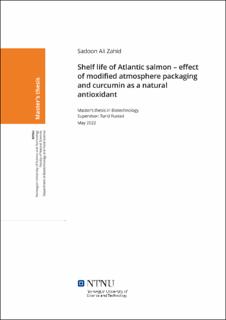| dc.contributor.advisor | Rustad, Turid | |
| dc.contributor.author | Zahid, Sadoon Ali | |
| dc.date.accessioned | 2022-07-15T17:20:32Z | |
| dc.date.available | 2022-07-15T17:20:32Z | |
| dc.date.issued | 2022 | |
| dc.identifier | no.ntnu:inspera:110630667:64912745 | |
| dc.identifier.uri | https://hdl.handle.net/11250/3005917 | |
| dc.description.abstract | Sjømat tilbyr sunnere alternativer til kjøtt, noe som er en av grunnene til at forbrukeren etterspørselen etter ferske fiskeprodukter av høy kvalitet hadde økt. Atlantisk laks er en god kilde av omega-3 fettsyrer, proteiner, vitaminer og mineraler. Den økte etterspørselen står overfor utfordringer på grunn av biokjemisk og mikrobiell ødeleggelse i fisken. Siden fisk er høyt lett bedervelig mat det er behov for nye og forbedrede konserveringsmetoder. Søknaden av modifisert atmosfærisk emballasje (MAP) og antioksidanter i kombinasjon er vist å være lovende når det gjelder å forhindre mikrobiell ødeleggelse og forsinke lipidoksidasjon, dermed forlenge holdbarheten til laks. Målet med denne oppgaven var å studere de kombinerte effektene av vakuum eller MAP emballasje med påføring av curcumin antioksidant for å forlenge holdbarhet på atlantisk laks.
Curcumin antioksidantløsninger ble ekstrahert og evaluert for antioksidantaktivitet ved bruk av DPPH og ABTS analyser. Atlantisk laks ble brukt til å gjennomføre to lagringsforsøk, hver varer i 15 dager. I det første lagringsforsøket, vakuum, og vakuum i kombinasjon med curcuminløsninger mens i det andre eksperimentet, MAP (CO2:N2 60:40) og MAP i kombinasjon med curcuminløsning ble lagret ved 0°C inntil videre prøvetaking ble utført på dag 3, 8, 13 og 15. Drypptapet, fargen og mikrobiell vekst var parameterne som ble brukt å analysere kvalitetsendringene. Det totale lipidinnholdet ble bestemt, og primær- og sekundære oksidasjonsprodukter ble målt ved bruk av PV og TBARS.
Drypptapet økte under lagring, og vakuumbehandlede prøver viste høyere drypp tap enn MAP-behandlede prøver. Både vakuum- og MAP-behandling og bruk av curcumin klarte ikke å forhindre mikrobiell ødeleggelse. Den mikrobielle veksten nådde det anbefalte forbruk etter 8 og 13 dagers lagring. Som curcumin løsninger hadde betydelig antioksidantaktivitet, ble PV i MAP med curcuminbehandlede prøver funnet å være lavere enn vakuumbehandlede prøver med lagringsdagene. TBARS-verdiene økte i alle prøvene med lagringsdagene som indikerer dannelsen av sekundære oksidasjonsprodukter. Både PV og TBARS-verdier antydet at til tross for lipidoksidasjonen, var ikke lipidene harske.
Avslutningsvis viste studien at MAP er fordelaktig sammenlignet med vakuum i å holde kvaliteten på laksen. Bruken av antioksidanter kombinert med MAP påvirket også parametere til en viss grad. Studien antydet også at curcumin-løsninger har potensielt forårsake en forsinkelse i lipidoksidasjon.
(My supervisor told me that as I am not a native speaker of the Norwegian language, I did not need to provide the Abstract in Norwegian that is why I did not include the Norwegian version in final thesis.) | |
| dc.description.abstract | Seafood offers healthier alternatives to meat, which is one of the reasons why consumer demand for fresh and quality fish products had increased. Atlantic salmon is a good source of omega-3 fatty acids, proteins, vitamins, and minerals. The increased demand is facing challenges due to biochemical and microbial spoilage in the fish. Since fish is highly perishable food there is a need for new and improved preservation methods. The application of modified atmospheric packaging (MAP) and antioxidants in combination have been shown to be promising in preventing microbial spoilage and delaying lipid oxidation, thus prolonging the shelf life of salmon. The aim of this thesis was to study the combined effects of vacuum or MAP packaging with the application of curcumin antioxidant to prolong the shelf life of Atlantic salmon.
Curcumin antioxidant solutions were extracted and evaluated for antioxidant activity using DPPH and ABTS assays. Atlantic salmon was used to conduct two storage experiments, each lasting 15 days. In the first storage experiment, vacuum, and vacuum in combination with curcumin solutions while in the second experiment, MAP (CO2:N2 60:40) and MAP in combination with curcumin solution were stored at 0°C until further sampling was done on days 3, 8, 13 and 15. The drip loss, color, and microbial growth were the parameters used to analyze the quality changes. The total lipid content was determined, and the primary and secondary oxidation products were measured using PV and TBARS.
The drip loss increased during storage, and vacuum treated samples showed higher drip losses than MAP treated samples. Both vacuum and MAP treatment and the use of curcumin failed to prevent microbial spoilage. The microbial growth reached the recommended consumption after 8 and 13 days of storage. As the curcumin solutions possessed significant antioxidant activity, the PV in MAP with curcumin-treated samples was found to be lower than vacuum treated samples with the storage days. TBARS values increased in all samples with the storage days indicating the formation of secondary oxidation products. Both PV and TBARS values suggested that despite the lipid oxidation, the lipids were not rancid.
In conclusion, the study showed that MAP is advantageous compared to vacuum in retaining the quality of salmon. The use of antioxidants combined with MAP also affected the parameters to some extent. The study also suggested that curcumin solutions have the potential to cause a delay in lipid oxidation. | |
| dc.language | eng | |
| dc.publisher | NTNU | |
| dc.title | Shelf life of Atlantic salmon – effect of modified atmosphere packaging and curcumin as a natural antioxidant | |
| dc.type | Master thesis | |
